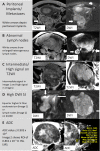MRI Evaluation of Uterine Masses for Risk of Leiomyosarcoma: A Consensus Statement
- PMID: 36194109
- PMCID: PMC9885356
- DOI: 10.1148/radiol.211658
MRI Evaluation of Uterine Masses for Risk of Leiomyosarcoma: A Consensus Statement
Abstract
Laparoscopic myomectomy, a common gynecologic operation in premenopausal women, has become heavily regulated since 2014 following the dissemination of unsuspected uterine leiomyosarcoma (LMS) throughout the pelvis of a physician treated for symptomatic leiomyoma. Research since that time suggests a higher prevalence than previously suspected of uterine LMS in resected masses presumed to represent leiomyoma, as high as one in 770 women (0.13%). Though rare, the dissemination of an aggressive malignant neoplasm due to noncontained electromechanical morcellation in laparoscopic myomectomy is a devastating outcome. Gynecologic surgeons' desire for an evidence-based, noninvasive evaluation for LMS is driven by a clear need to avoid such harms while maintaining the availability of minimally invasive surgery for symptomatic leiomyoma. Laparoscopic gynecologists could rely upon the distinction of higher-risk uterine masses preoperatively to plan oncologic surgery (ie, potential hysterectomy) for patients with elevated risk for LMS and, conversely, to safely offer women with no or minimal indicators of elevated risk the fertility-preserving laparoscopic myomectomy. MRI evaluation for LMS may potentially serve this purpose in symptomatic women with leiomyomas. This evidence review and consensus statement defines imaging and disease-related terms to allow more uniform and reliable interpretation and identifies the highest priorities for future research on LMS evaluation.
© RSNA, 2022.
Conflict of interest statement
Figures







References
-
- Baird DD , Dunson DB , Hill MC , Cousins D , Schectman JM . High cumulative incidence of uterine leiomyoma in black and white women: ultrasound evidence . Am J Obstet Gynecol 2003. ; 188 ( 1 ): 100 – 107 . - PubMed
-
- Stewart EA , Cookson CL , Gandolfo RA , Schulze-Rath R . Epidemiology of uterine fibroids: a systematic review . BJOG 2017. ; 124 ( 10 ): 1501 – 1512 . - PubMed
-
- Laparoscopic Uterine Power Morcellation in Hysterectomy and Myomectomy: FDA Safety Communication . https://wayback.archive-it.org/7993/20170404182209/https:/www.fda.gov/Me.... Published 2014. Accessed August 5, 2020 .
-
- Durand-Réville M , Dufour P , Vinatier D , et al. . Uterine leiomyosarcomas: a surprising pathology. Review of the literature. Six case reports [in French] . J Gynecol Obstet Biol Reprod (Paris) 1996. ; 25 ( 7 ): 710 – 715 . - PubMed
Publication types
MeSH terms
Grants and funding
LinkOut - more resources
Full Text Sources
Medical

